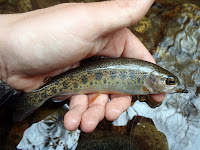From our ol' pal Landon Williams:
In case you haven’t heard, Georgia's trout season opening day is less than three weeks away!
 For many of us, this reminds us that we will soon have many more miles of streams open to fishing that were previously closed and they will have many new fish stocked into them. However, there is a sort of fringe group that are anticipating this date for another reason: the seasonal opening of all of the wild trout streams that abound throughout North Georgia. Now, this is not to say that there are no wild trout streams that do not have the year round designation like our Delayed Harvest streams and bigger rivers such as the Chattahoochee near Atlanta or the Toccoa. However, the vast majority are closed to fishing after October 31 every year until they reopen the next spring at the end of March. Wild trout are a very desirable quarry for many, but some folks find it difficult to find good streams to fish outside of word of mouth from fellow anglers. Despite this, the resources exist out there and many are available over the internet if you are tech savvy!
For many of us, this reminds us that we will soon have many more miles of streams open to fishing that were previously closed and they will have many new fish stocked into them. However, there is a sort of fringe group that are anticipating this date for another reason: the seasonal opening of all of the wild trout streams that abound throughout North Georgia. Now, this is not to say that there are no wild trout streams that do not have the year round designation like our Delayed Harvest streams and bigger rivers such as the Chattahoochee near Atlanta or the Toccoa. However, the vast majority are closed to fishing after October 31 every year until they reopen the next spring at the end of March. Wild trout are a very desirable quarry for many, but some folks find it difficult to find good streams to fish outside of word of mouth from fellow anglers. Despite this, the resources exist out there and many are available over the internet if you are tech savvy!Perhaps the most useful tool that one can acquire for researching wild trout streams is a quality map of the Chattahoochee National Forest. There are many maps that not only show the forest service roads but also many of the streams and their names as well. My personal favorite can be found by clicking here and the different areas of the forest can be accessed by clicking on the map. The digital copies are nice but an actual in-hand copy is invaluable when you are out and about actually looking for the streams. For those who are more adventurous and familiar with the technology, GPS units are also handy when you get way off the beaten track, as you often do with this type of fishing.
Aside from finding the streams, there are a few things to remember in your search. Rainbows and browns are the most likely trout you are to encounter in our trout streams here in North Georgia. They are quite numerous and can prosper in streams even at relatively low elevations. There are not many streams predominated by brown trout, but they do exist, especially at the lower elevation (1500 ft. or so) and lower gradient streams. Rainbows tend to take over as the water speed and gradient of the stream increase. Both species certainly do mix but these are generally good trends to follow if you are also following along with your research with a topographic map featuring elevations.
If you are interested in the highly coveted Brook Trout, generally the angler will have to go much higher up in elevation. This is not necessarily due to their demands for colder water but in large part due to being outcompeted by invasive rainbows and browns. Brookies are usually found in sections of streams located above large waterfalls that inhibit the movement of rainbows and browns into their sections of water. Many regular brook trout anglers are convinced that a section of water located above a “barrier falls” and 2500+ ft. in elevation is the formula for finding brook trout regularly. Also of interest are the “Back the Brookie” streams that have received stream enhancement projects from TU, GA DNR, and the Forestry Service. They are a great starting point, especially for new wild trout anglers.
Good luck in your research efforts in the coming weeks. The wet winter that we have had should have stream levels in great shape for this spring!






No comments:
Post a Comment